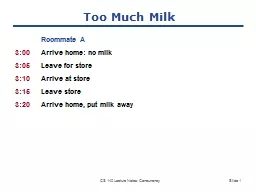PPT-CS1020 Lecture Note #7:
Author : tatyana-admore | Published Date : 2017-01-14
Object Oriented Programming Inheritance Like father like son Objectives 2 Introducing inheritance through creating subclasses Improve code reusability Allowing overriding
Presentation Embed Code
Download Presentation
Download Presentation The PPT/PDF document "CS1020 Lecture Note #7:" is the property of its rightful owner. Permission is granted to download and print the materials on this website for personal, non-commercial use only, and to display it on your personal computer provided you do not modify the materials and that you retain all copyright notices contained in the materials. By downloading content from our website, you accept the terms of this agreement.
CS1020 Lecture Note #7:: Transcript
Download Rules Of Document
"CS1020 Lecture Note #7:"The content belongs to its owner. You may download and print it for personal use, without modification, and keep all copyright notices. By downloading, you agree to these terms.
Related Documents














